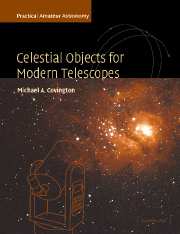B - Precession from 1950 to 2000
Published online by Cambridge University Press: 22 September 2009
Summary
Many older maps still use epoch 1950 coordinates. To convert right ascensions and declinations from 1950 to 2000, find the entry in Table B.1 nearest the object's position in the sky and add the corrections indicated there.
To convert 2000 coordinates to 1900 for AAVSO variable-star designations and the like, double the tabulated correction and apply it in the opposite direction (subtracting instead of adding and vice versa).
To calculate precession, let α and δ stand for the object's initial right ascension and declination respectively, both expressed in degrees. (Recall that 1h = 15°.) Let N stand for the number of years between epochs (negative if you are converting from a later epoch to an earlier one). Then compute:
R.A. correction (in seconds) = (3.073 + 1.336 sin α tan δ) × N
Declination correction (in arc-seconds) = (20.042 cos α) × N
and add the corrections to the original R.A. and declination.
These formulae are for dates within a couple of centuries of 2000 and positions at least 0.1° away from the celestial poles. For more accurate formulae see the Astronomical Almanac published by the U.S. and British governments.
- Type
- Chapter
- Information
- Celestial Objects for Modern TelescopesPractical Amateur Astronomy Volume 2, pp. 249 - 251Publisher: Cambridge University PressPrint publication year: 2002



